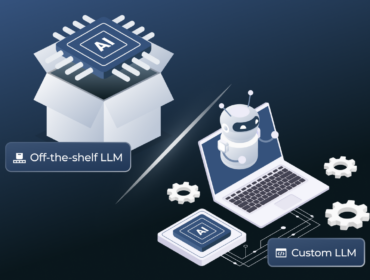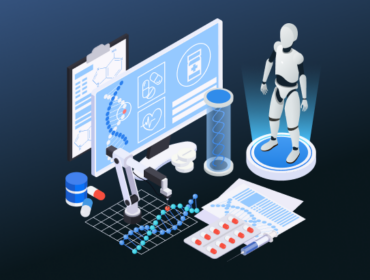In 2022, Artificial Intelligence has become one of the most in-demand business technologies. Businesses are increasingly adopting new technologies to win over users and stay competitive in the market. As Gartner states, every company is a technology company. Applying the right technologies and getting the most out of the benefits they offer can be a real differentiator.
An AI-enabled project differs from a conventional software development project. Thus, managing AI projects require a special approach. When developing a traditional software solution, a team of developers is responsible for coding the app’s logic. On the other hand, AI apps don’t require explicitly coded logic. ML algorithms can learn the necessary patterns.
But still, they have something in common. As with any other technology, businesses looking to power up their services with AI need to start with Proof of Value (PoV). A PoV ensures that your AI-powered solution will satisfy your business’s expectations. Here’s what you need to know about managing AI projects.
Managing AI Projects: The Basics
Below six are key steps that you need to cover the process of AI project management. They include:
- Identifying a business problem
- Testing the problem-solution fit
- Collecting and preparing data
- Choosing the right AI-based algorithm
- Training the algorithm
- Deploying the product
As you can see, AI project management is slightly different from managing traditional software development processes. Despite the popularity of AI technologies, business solutions can become unnecessarily complex with AI components. Before starting development on an AI-enabled software solution, you need to clearly understand why you need AI.
-
Understand how AI will be used within YOUR company
Make sure that you understand the requirements and what you’re trying to solve with an AI-enabled solution. There should be a clear problem that you need to solve or value you need to create. This is the area where a vast majority of teams fail. In this case, there can be two outcomes. A team can build specific machine learning models with particular attributes. Or another team can build models that do not provide any value since the business already has all the data and insights provided by the model.
Understanding the real business needs and challenges is an important aspect that shouldn’t be overlooked when developing AI-enabled software solutions. Make sure that your team has all the information. Otherwise, they won’t be able to brainstorm and prioritize tasks (what data to use, what to predict, how to analyze).
-
Know the architecture of the AI project
While building an AI-powered solution, you need to understand its constituent parts. Like with any other software project, AI apps consist of a front-end component (how users see the app) and a back-end component (how the app works). But they also have an ML component (how an app learns and generates predictions).
Let’s take Netflix as an example of an AI-enabled platform. Its back-end component allows users to watch their favorite movies and series while keeping track of different users. Its front-end component shows the player and enables users to interact with content. And the ML component generates what a user might want to watch based on their previous choices and likes.
But not all AI systems are so simple. The architecture is more complex when embedded into other real-time systems like self-driving cars. There are multiple ML components (one to monitoring surroundings in real-time, one for following the road, one to avoid colliding with objects, etc.)
-
Understanding the software development life cycle for AI projects
Generally, a software development project goes through several phases according to the software development lifecycle. But when developing an AI or ML-enabled app, there are some additional steps your team shouldn’t overlook in the timeline. Here are some extra tasks to consider with your AI team during the planning stage:
- Understand the business problem
- Collect, clean, and prepare data
- Build and train the model
- Deploy the model
- Test and analyze the workings of the model
Note that your team may need to return to previous steps. When building an ML model, you may also find yourself in need of additional data. Also, collecting and managing data may take more time than you originally planned.
-
Determine milestones
There are high chances that your development team may need to return to previous steps. In this case, it’s better to take advantage of flexible sprint planning. Going entirely without sprints can complicate and even burden the development of any software product. There needs to be a process that coordinates the goals and tasks within the team.
The team needs have set metrics and milestones that they can aim for while developing the AI solution. Apart from usual machine learning metrics such as accuracy, recall, precision, and so on, there should also be some business metrics. Customers won back, generated revenue, and market penetration are top business metrics to pay attention to. Actually, you can set your own metrics that are tied to the business.
-
Know when it is time to scale up
In most cases, it’s smart to start small and then scale up the project in small stages rather than deploying a system at scale. There is no need to throw everything over the wall and develop a full-scale AI solution for your business.
It’s better to start small and test your idea without massive investments of both time and money. Scaling up is less risky than deploying an AI-enabled system at scale.
Summing Up
87% of data science projects fail without going into production, according to VentureBeat. The main reason for this rate of failure is the absence of leadership support and collaboration. Project managers, developers, and data scientists are not aware of every trick in the business book. There are no masterclasses or online courses that teach all the ins and outs of a business without actually owning it.
Planning and managing AI projects requires tight cooperation between project sponsors (business owners) and the development team. Ensuring that the AI project’s goals fully satisfy the business needs and requirements is a primary goal for every project manager. That’s why as a business owner, you’ll need to be ready to share your business insights and tell the team as much about your workflows as possible to deploy an AI system capable of exceeding your business’s needs.





![How To Manage AI Projects? What’s the EU Artificial Intelligence Act and How to Comply? [Webinar]](https://unicsoft.com/wp-content/uploads/2024/03/Cover_1140_v1.1-370x280.png)

